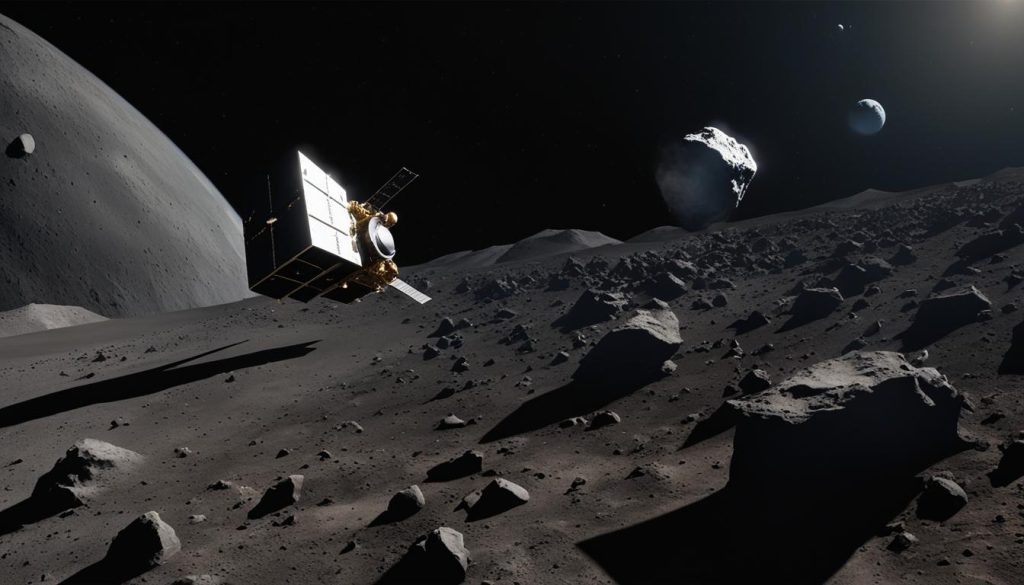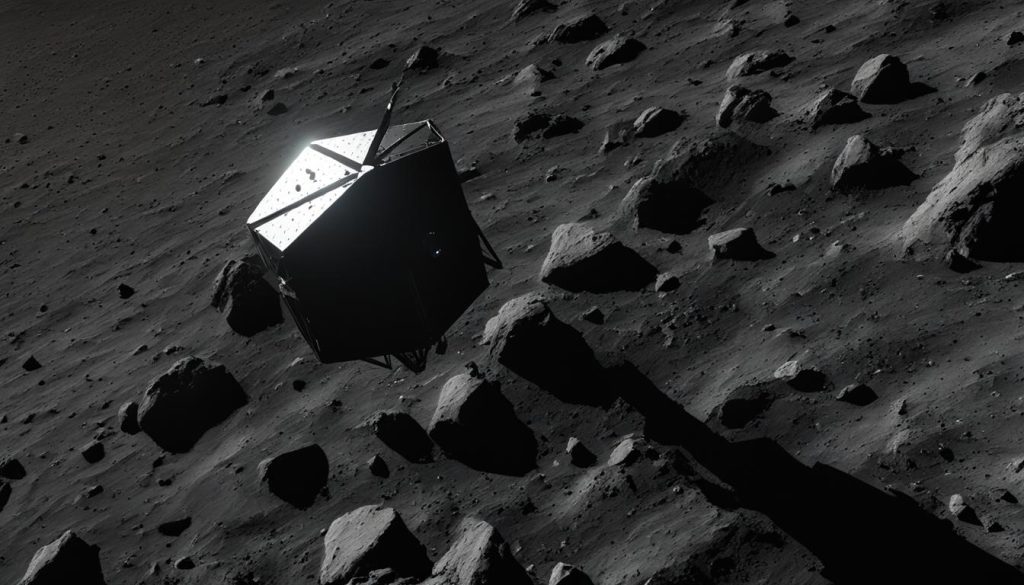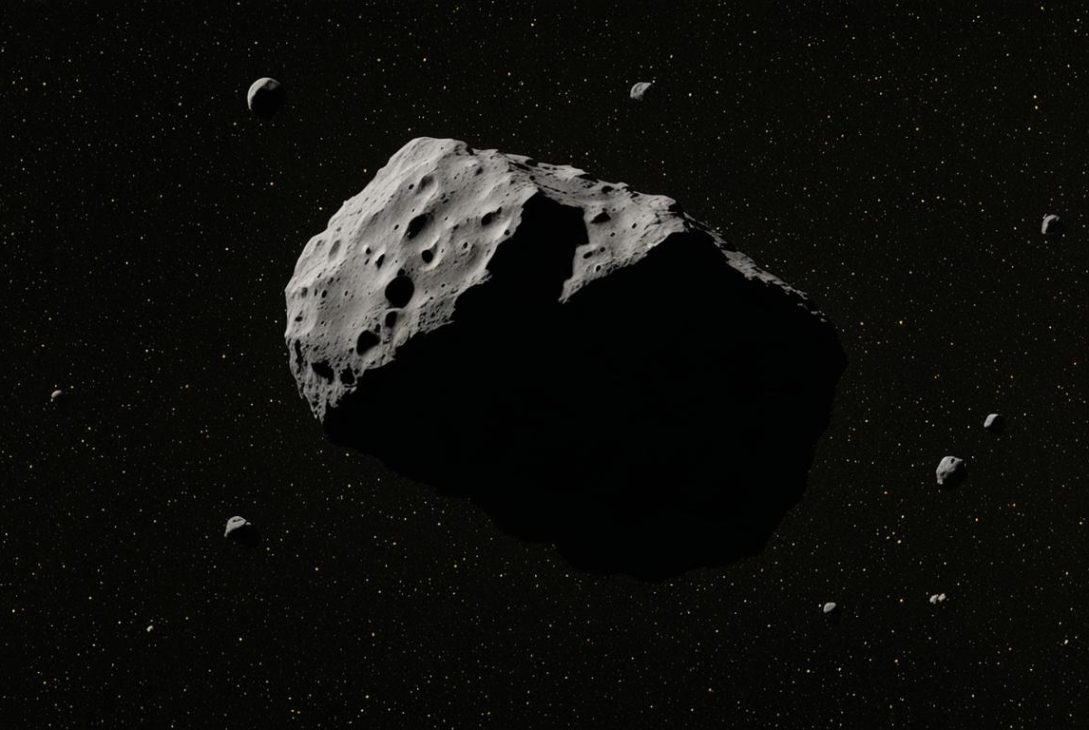NASA has embarked on an ambitious mission to intercept the asteroid known as the “God of Chaos.” As part of their ongoing efforts to study and understand asteroids, this mission holds great significance for scientists and researchers.
The main objective of this mission is to closely study the asteroid, officially named Apophis, which is expected to pass within 20,000 miles of Earth in April 2029. This close encounter provides a unique opportunity for NASA to gather valuable insights into the asteroid’s surface and its interaction with Earth’s gravity.
The God of Chaos mission involves the deployment of the OSIRIS-APEX spacecraft, which is specifically designed for deep space exploration and asteroid study. This spacecraft, previously known as OSIRIS-REx, has already successfully completed a mission to gather a sample from the asteroid Bennu.
By intercepting Apophis during its close approach to Earth, OSIRIS-APEX will conduct a range of scientific investigations, including mapping the asteroid’s surface, analyzing its chemical composition, and closely observing any changes that occur as a result of its encounter with Earth’s gravity.
The study of Apophis holds significant importance for planetary defense research. Most potentially dangerous asteroids belong to the same type as Apophis, known as Type S asteroids. By studying this particular asteroid, scientists can gain crucial insights into the behavior and characteristics of these asteroids, ultimately contributing to the development of strategies to protect our planet from future impacts.
In conclusion, the NASA mission to intercept the “God of Chaos” asteroid, Apophis, represents a remarkable opportunity for scientific exploration and understanding. With the OSIRIS-APEX spacecraft leading the way, this mission promises to provide us with valuable information about the asteroid’s surface, composition, and close approach to Earth. Through this mission, NASA aims to further our knowledge of asteroids, planetary formation, and defense, paving the way for future advancements in space exploration.
Key Takeaways:
- NASA has launched a mission to intercept the “God of Chaos” asteroid, Apophis, during its close approach to Earth.
- The OSIRIS-APEX spacecraft will conduct scientific investigations, mapping the asteroid’s surface and analyzing its composition.
- Studying Apophis is crucial for planetary defense research and understanding the behavior of potentially dangerous asteroids.
- This mission contributes to our knowledge of planetary formation, defense, and future space exploration endeavors.
OSIRIS-APEX: Exploring Apophis
NASA’s OSIRIS-APEX spacecraft, formerly known as OSIRIS-REx, is on a mission to study the asteroid Apophis. The spacecraft, which successfully returned a sample from the asteroid Bennu, is now embarking on a new journey to explore Apophis during its close approach to Earth in 2029.
OSIRIS-APEX is a deep space mission that will provide valuable insights into the formation of the solar system and contribute to planetary defense research. By studying Apophis up close, scientists aim to unravel its mysteries and gain a better understanding of asteroids and their role in the cosmos.
To capture the attention of the readers and give a sneak peek into the upcoming journey, an image of the OSIRIS-APEX spacecraft can be placed here:
This mission is a testament to NASA’s commitment to exploring the depths of space and expanding our knowledge of the universe. Through the use of advanced technology and rigorous scientific research, OSIRIS-APEX aims to unlock the secrets hidden within Apophis and pave the way for future asteroid explorations.
“The OSIRIS-APEX mission represents the next frontier in asteroid study and deep space exploration. By delving into the mysteries of Apophis, we hope to gain valuable insights into the formation of our solar system and potentially mitigate the threat of potentially dangerous asteroids.”
Scientific Objectives of OSIRIS-APEX
During its mission at Apophis, OSIRIS-APEX will focus on achieving the following scientific objectives:
- Study the asteroid’s surface changes: By closely observing Apophis, the spacecraft will monitor any alterations to its surface caused by its interaction with Earth’s gravity.
- Analyze the chemical composition: OSIRIS-APEX will utilize a suite of instruments, including imagers and spectrometers, to conduct chemical composition analysis and reveal insights into the asteroid’s composition and origins.
- Conduct close-range observations: The spacecraft will approach within 16 feet of Apophis’s surface, capturing detailed imagery and conducting further scientific investigations.
The data collected by OSIRIS-APEX during its mission will contribute to our understanding of not just Apophis, but also asteroids in general, shedding light on their formation and potential hazards they may pose to Earth.
To summarize the scientific objectives of OSIRIS-APEX, the following table highlights its key investigations:
| Scientific Objectives | Description |
|---|---|
| Surface Changes | Closely monitor any changes to the asteroid’s surface caused by its interaction with Earth’s gravity. |
| Chemical Composition Analysis | Analyze the chemical composition of Apophis to gain insights into its origins and composition. |
| Close-Range Observations | Approach within 16 feet of Apophis’s surface to capture detailed imagery and conduct further scientific investigations. |
Apophis: The Close Encounter
On April 13, 2029, Apophis, the asteroid of interest, is set to make an exceptionally close approach to Earth. While there is no risk of impact, Apophis will come within 20,000 miles of our planet, which is closer than some satellites in orbit. This proximity provides a rare opportunity for astronomers and sky enthusiasts alike to witness a celestial spectacle.
In the Eastern Hemisphere, there is a possibility that Apophis will be visible to the naked eye during its close encounter. This makes it an exceptional event to observe for those in regions such as Asia, Australia, Africa, and Europe. Stargazers can anticipate a unique viewing experience as they witness the close flyby of this monumental asteroid.
Aside from its visibility, Apophis’ close approach will have profound effects on its orbit and potentially trigger seismic activity and landslides on its surface. This interaction with Earth’s gravitational pull will cause the asteroid’s trajectory to be altered, highlighting the dynamic nature of celestial bodies and their interactions within our solar system.
“The close encounter with Apophis presents an unprecedented window into studying the effects of gravitational forces on an asteroid’s trajectory. It allows us to gain invaluable insights into how asteroids interact with Earth and potentially impact their future paths,” said Dr. Rebecca Miller, a leading astrophysicist.
Understanding the behavior and dynamics of asteroids like Apophis is crucial for planetary defense efforts and improving our ability to predict and mitigate future impacts. By studying Apophis’ close encounter, scientists can gather valuable data to refine our models and strategies for safeguarding our planet from potentially dangerous asteroids.
| Key Facts about Apophis’ Close Approach | |
|---|---|
| Closest Approach Distance | 20,000 miles |
| Potential Visibility | Visible in the Eastern Hemisphere |
| Effects on Orbit | Altered trajectory due to Earth’s gravity |
| Possible Consequences | Seismic activity and landslides on Apophis’ surface |
Scientific Objectives of OSIRIS-APEX
The OSIRIS-APEX spacecraft is equipped with a suite of advanced instruments that will enable scientists to conduct a wide range of scientific investigations during its mission at Apophis. These investigations are aimed at gathering crucial data and insights about the asteroid’s surface changes, chemical composition, and other key characteristics.
One of the primary scientific objectives of OSIRIS-APEX is to closely observe and record any changes that occur on the asteroid’s surface as a result of its encounter with Earth’s gravity. By monitoring these surface changes, scientists will be able to gain a deeper understanding of the dynamics and processes that shape the evolution of asteroids.
The spacecraft will also utilize its state-of-the-art imagers, spectrometers, and a laser altimeter to map the detailed topography of Apophis’s surface. This comprehensive mapping will provide valuable insights into the asteroid’s geological features, such as craters, ridges, and valleys, and help scientists uncover clues about its formation and history.
Furthermore, OSIRIS-APEX will conduct extensive chemical composition analysis of Apophis. The spacecraft will analyze the abundance of different elements and minerals present on the asteroid’s surface, which will shed light on its composition and provide important clues about its origin and evolution. This analysis will be crucial in unraveling the mysteries surrounding the formation and evolution of asteroids in our solar system.
Perhaps one of the most exciting aspects of the OSIRIS-APEX mission is its capability to approach within 16 feet of Apophis’s surface. By getting up close and personal with the asteroid, the spacecraft will be able to stir up rocks and dust, allowing scientists to study the subsurface layers and gain insights into the composition and structure beneath the surface.
This comprehensive suite of scientific objectives, combined with the advanced capabilities of the spacecraft instruments, will enable OSIRIS-APEX to provide groundbreaking insights into the nature and characteristics of Apophis, contributing significantly to our understanding of asteroids and their role in the formation and evolution of our solar system.
Importance for Planetary Defense
The study of Apophis is crucial for planetary defense research. Most known potentially dangerous asteroids belong to the same type as Apophis, known as Type S asteroids. By studying Apophis, scientists can gain valuable insights into the characteristics and behavior of these asteroids, helping to develop strategies to protect Earth from future impacts.
| Keyword | Definition |
|---|---|
| Planetary defense research | The scientific study and development of strategies to safeguard Earth from potential asteroid impacts. |
| Potentially dangerous asteroids | Asteroids that pose a risk of collision with Earth and have the potential to cause significant damage. |
| Type S asteroids | A specific classification of asteroids, including Apophis, sharing similar characteristics and composition. |
Understanding the nature of Type S asteroids like Apophis is crucial for enhancing our ability to detect, track, and mitigate potential threats. By analyzing their composition and behavior, scientists can develop effective defense strategies, such as deflection missions or early warning systems, to protect our planet. The data gathered from Apophis will contribute to ongoing research and preparation for future encounters with potentially dangerous asteroids.
Studying Apophis helps us gain insights into the characteristics and behavior of Type S asteroids, allowing us to develop robust defense strategies against potentially dangerous asteroids. It is an integral part of our ongoing efforts to safeguard our planet from future impacts.
OSIRIS-APEX Mission Timeline
The OSIRIS-APEX mission to Apophis is carefully scheduled to maximize scientific observations and gather valuable data during the asteroid’s close approach to Earth. The mission timeline is as follows:
- April 2029 (Two weeks before Apophis’s close approach): The spacecraft’s cameras start capturing images as OSIRIS-APEX catches up with the asteroid, providing valuable visual data.
- Close encounter: Ground-based telescopes also observe Apophis during its close approach, complementing the data collected by OSIRIS-APEX.
- April 13, 2029: OSIRIS-APEX reaches Apophis’s vicinity and begins operating in close proximity to the asteroid for approximately 18 months.
- Scientific observations: Throughout its mission, OSIRIS-APEX will conduct various scientific observations, gathering data on Apophis’s surface composition, structure, and dynamics.
- Descent to the asteroid’s surface: OSIRIS-APEX will descend to within 16 feet of Apophis’s surface, enabling detailed investigations and sample collection.
The mission timeline ensures that OSIRIS-APEX optimizes its scientific capabilities, capturing valuable data during Apophis’s rendezvous with Earth. These observations will contribute to our understanding of asteroid dynamics, planetary formation, and planetary defense strategies.

Learning from Apophis for Planetary Formation
Apophis’s close approach to Earth offers a remarkable opportunity to gain insights into planetary formation by studying the effects of tidal forces and debris accumulation. These natural processes play a vital role in the evolution of our solar system, from a cloud of debris to fully formed planets. By examining the surface changes and characteristics of Apophis, scientists aim to uncover valuable information about the early stages of planet formation.
The Impact of Tidal Forces
Tidal forces, caused by the gravitational interaction between celestial bodies, can lead to significant changes in the shape and composition of objects like Apophis. As the asteroid journeys close to Earth, tidal forces exerted by our planet can induce deformations and stress on its surface. Studying these effects will enhance our understanding of how planets shaped by tidal forces evolve over time.
Debris Accumulation and Planet Formation
The accumulation of debris, such as asteroids and comets, is a critical aspect of planet formation. By analyzing the characteristics and composition of Apophis, scientists can gain valuable insights into the materials that contributed to the formation of rocky planets like Earth. This knowledge can provide clues about the conditions and processes that led to the creation of habitable worlds in our solar system and beyond.
Understanding the role of tidal forces and debris accumulation in planetary formation is crucial for unraveling the mysteries of our own solar system and discovering the potential for life on other planets.
Contributing to Solar System Evolution
Exploring Apophis and studying its surface changes has broader implications for understanding the evolution of our entire solar system. By examining the remnants of early solar system materials, scientists can piece together the complex history of planet formation and the dynamics that shaped our cosmic neighborhood. Apophis serves as a tangible relic of the past, providing valuable insights into the processes that have shaped our world and others.
The Unprecedented Nature of Apophis’s Close Approach
Apophis’s close approach to Earth is a rare event. Asteroids of Apophis’s size, approximately 340 meters across, come this close to Earth only once every 7,500 years. This highlights the exceptional nature of Apophis’s flyby in 2029 and the scientific significance of studying this unique event.
OSIRIS-APEX Mission Success at Bennu
OSIRIS-REx, the predecessor to OSIRIS-APEX, achieved remarkable success in its mission to collect a sample from the asteroid Bennu. The spacecraft’s mission was executed flawlessly, resulting in the safe delivery of the asteroid sample back to Earth. Even after this monumental achievement, OSIRIS-REx was left with a quarter of its fuel and its instruments were in excellent condition.
This extraordinary success prompted NASA to make the decision to extend the mission of OSIRIS-REx, now known as OSIRIS-APEX, and redirect the spacecraft towards its next target – the asteroid Apophis. The capabilities and performance of the spacecraft have been truly exceptional, enabling scientists to embark on another groundbreaking exploration.
OSIRIS-REx Mission Highlights:
Successful Sample Collection from Asteroid Bennu: OSIRIS-REx set a new standard for asteroid sample collection, acquiring a pristine sample from the surface of Bennu. This achievement was a testament to the spacecraft’s advanced capabilities and the expertise of the mission’s team.
Optimal Fuel Reserves: Remarkably, OSIRIS-REx had approximately a quarter of its fuel remaining after completing its mission at Bennu. This surplus fuel played a crucial role in the decision to extend the mission and redirect the spacecraft towards Apophis, ensuring that OSIRIS-APEX can continue its groundbreaking exploration.
Intact Instrumentation: Despite the rigorous demands of its mission at Bennu, OSIRIS-REx emerged with its instruments in exceptional condition, ready for further scientific investigations. This demonstrated the durability and reliability of the spacecraft’s instruments, further bolstering confidence in its capabilities.
OSIRIS-REx Mission Statistics
| Mission Achievement | Details |
|---|---|
| Sample Collection Success | Exemplary acquisition of a sample from the asteroid Bennu. |
| Fuel Reserves | Approximately a quarter of the fuel remaining. |
| Instrumentation Condition | Instruments in excellent condition, ready for further scientific investigations. |
OSIRIS-REx’s triumph at Bennu paved the way for the continuation of its mission as OSIRIS-APEX. With its impressive track record, the spacecraft is poised to uncover further revelations during its exploration of the asteroid Apophis.

International Collaborations and Partnerships
The OSIRIS-APEX mission is a testament to the power of international collaborations and partnerships. To achieve its scientific objectives, the mission has brought together the expertise and resources of multiple international space agencies. One of the key contributions comes from the Canadian Space Agency, which provided the laser altimeter instrument. This instrument plays a crucial role in mapping the surface of the asteroid Apophis, enabling scientists to gain valuable insights into its composition and structure.
Furthermore, the OSIRIS-APEX mission is also engaging in scientific cooperation with Japan Aerospace Exploration Agency’s (JAXA) Hayabusa2 mission. Hayabusa2, which successfully returned samples from the asteroid Ryugu, has provided valuable knowledge and data that can complement the research conducted by OSIRIS-APEX. By working together, these international partnerships enhance the scientific capabilities and collaborative efforts in studying asteroids and understanding the formation of our solar system.
Through these collaborations, space agencies from different nations are pooling their expertise, resources, and data to tackle the mysteries of the universe. Such international scientific cooperation fosters knowledge sharing, global collaboration, and encourages groundbreaking discoveries that can expand our understanding of the cosmos.
NASA’s New Frontiers Program
OSIRIS-APEX is part of NASA’s New Frontiers program, which focuses on deep space exploration through scientifically driven missions. This program aims to expand our understanding of the solar system and its formation through missions like OSIRIS-APEX, contributing to scientific advancements and planetary defense research.
Program Objectives
The New Frontiers program prioritizes deep space exploration to push the boundaries of scientific knowledge. The primary objectives of the program include:
- Investigating pristine solar system materials
- Exploring ancient objects that hold clues to the early history of our solar system
- Studying key locations for potential future human exploration
- Advancing our understanding of planetary processes and dynamics
The Role of OSIRIS-APEX
OSIRIS-APEX plays a pivotal role in the New Frontiers program by focusing on the exploration and study of asteroids like Apophis. By venturing into deep space and conducting scientific missions, this program aims to gather crucial data and insights to enhance our knowledge of the solar system’s formation and evolution.
“The New Frontiers program allows us to embark on ambitious missions that break new ground in deep space exploration. Through scientific missions like OSIRIS-APEX, we can better understand the mysteries of our solar system and protect our planet from potential threats.” – NASA Administrator
Advancements in Deep Space Exploration
The New Frontiers program represents a significant advancement in deep space exploration. By using innovative technologies and scientific expertise, missions like OSIRIS-APEX contribute to the ongoing quest for knowledge beyond Earth. These endeavors enable scientists to expand our understanding of the universe, uncover planetary secrets, and pave the way for future discoveries.
The Quest for Knowledge
The New Frontiers program embodies the spirit of exploration and the human desire to delve into uncharted territories. By pushing the boundaries of our scientific capabilities, NASA’s New Frontiers missions provide us with a greater understanding of the cosmos, our place within it, and the origins of our solar system.
| Mission | Objective | Status |
|---|---|---|
| OSIRIS-REx | To collect a sample from the asteroid Bennu | Successfully completed |
| Juno | To study Jupiter’s structure, atmosphere, and magnetic field | Operating and collecting data |
| New Horizons | To study Pluto, its moon Charon, and the Kuiper Belt | Completed primary mission and continuing exploration |
Conclusion
The NASA mission to intercept the “God of Chaos” asteroid, Apophis, marks a significant milestone in our ongoing exploration and understanding of asteroids and their potential impact on Earth. By studying Apophis’s surface changes, composition, and close approach to Earth, scientists can gain valuable insights into the formation of planets and develop strategies for planetary defense.
The OSIRIS-APEX spacecraft, formerly known as OSIRIS-REx, is at the forefront of this mission, leveraging its advanced instruments and capabilities to explore and study Apophis. This deep space mission not only builds upon the success of previous asteroid encounters but also contributes to our scientific knowledge of the solar system.
As we unveil new scientific discoveries through the OSIRIS-APEX mission, we are also advancing our efforts to protect Earth from potentially dangerous asteroids. By understanding the characteristics and behavior of asteroids like Apophis, we can develop effective strategies for planetary defense, ensuring the safety and well-being of our planet and its inhabitants.
FAQ
What is the goal of the NASA mission targeting the “God of Chaos” asteroid?
The goal of the NASA mission is to intercept the asteroid named “God of Chaos,” officially known as Apophis, and study its surface and the effects of its interaction with Earth’s gravity.
What is the name of the spacecraft involved in the mission to study Apophis?
The spacecraft involved in the mission to study Apophis is called OSIRIS-APEX, formerly known as OSIRIS-REx.
How close will Apophis come to Earth during its close approach in April 2029?
Apophis will come within 20,000 miles of Earth, closer than some satellites, during its close approach in April 2029.
What scientific investigations will be conducted by OSIRIS-APEX at Apophis?
OSIRIS-APEX will closely observe changes to Apophis’s surface, map its surface, analyze its chemical composition, and approach within 16 feet of its surface to reveal what lies beneath.
Why is studying Apophis important for planetary defense research?
Apophis belongs to the same type of asteroids as most known potentially dangerous asteroids. Studying Apophis will provide valuable insights into the characteristics and behavior of these asteroids, helping develop strategies to protect Earth from future impacts.
What is the timeline for the OSIRIS-APEX mission at Apophis?
The OSIRIS-APEX mission will start two weeks before Apophis’s close approach in April 2029. The spacecraft will reach Apophis on April 13, 2029, and operate in its vicinity for approximately 18 months.
What can be learned from Apophis’s close approach to Earth?
Apophis’s close approach will allow scientists to study the effects of tidal forces and debris accumulation on planet formation, shedding light on the early stages of the solar system’s evolution.
How often do asteroids of Apophis’s size come close to Earth?
Asteroids of Apophis’s size, approximately 340 meters across, come this close to Earth only once every 7,500 years.
What led to the decision to redirect the OSIRIS-APEX mission towards Apophis?
After successfully completing its mission to gather a sample from the asteroid Bennu, the OSIRIS-REx spacecraft had remaining fuel and operational instruments, making it suitable for exploring another asteroid like Apophis.
Are there any international collaborations and partnerships involved in the OSIRIS-APEX mission?
Yes, the OSIRIS-APEX mission involves collaborations and partnerships with international space agencies, including the Canadian Space Agency and the Japan Aerospace Exploration Agency’s Hayabusa2 mission.
What is the New Frontiers program of NASA?
The New Frontiers program of NASA focuses on deep space exploration through scientifically driven missions, contributing to scientific advancements and planetary defense research.
What is the significance of studying Apophis for NASA’s asteroid mission?
Studying Apophis’s surface changes, composition, and close approach to Earth provides valuable insights into planetary formation and defense, contributing to our efforts to protect Earth from potentially dangerous asteroids.
Source Links
- https://www.audacy.com/kywnewsradio/news/national/nasa-launches-mission-to-intercept-god-of-chaos-asteroid
- https://newsbeezer.com/nasas-daring-mission-to-intercept-the-god-of-chaos-asteroid-as-it-approaches-earth/
Asteroids have been a threat to Earth since the beginning of time. In fact, the very first impact hazard was an asteroid that hit Earth about 4.5 billion years ago. This impact created the Moon and the craters on its surface. Since then, there have been many other impacts, but none have been as catastrophic.
The most recent impact hazard was the Chelyabinsk meteor that exploded over Russia in 2013. This event was a wake-up call for many people. It showed that we are not prepared for an asteroid impact and that it could happen at any time.
Now, NASA is launching a mission to intercept an asteroid known as the “God of Chaos” asteroid. This asteroid has a 1 in 7,000 chance of hitting Earth in 2029. If it were to hit Earth, it would cause devastation on a global scale.
This mission is important because it will help us to understand how to deflect an asteroid and prevent it from hitting Earth. It will also give us valuable information about the composition of asteroids.
The “God of Chaos” asteroid is named after the Egyptian god of chaos, Set. This name was chosen because the asteroid’s orbit crosses that of Earth’s orbit. This makes it a potentially hazardous object.
The interceptor spacecraft will be launched in October 2024 and will reach the asteroid in 2029. It will then use a kinetic impactor to change the asteroid’s orbit. This will ensure that it will miss Earth when it comes close in 2036.
This is an important mission because it will help to protect our planet from a potential impact. It is also a great opportunity to learn more about asteroids and how to defend against them.
NASA Mission Targets ‘God of Chaos’ Asteroid
Last modified: December 28, 2023





